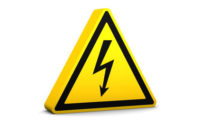Arc flash: a violent event
Can be inconsequential...or fatal

 An arc flash is distinctly different from the arc blast. It is part of an arc fault, a type of electrical explosion that results from a low-impedance connection to ground or another voltage phase in an electrical system.
An arc flash is distinctly different from the arc blast. It is part of an arc fault, a type of electrical explosion that results from a low-impedance connection to ground or another voltage phase in an electrical system.
An arc flash is light and heat. It’s produced from an electric arc supplied with sufficient electrical energy to cause substantial damage or harm, fire or injury.
Electrical arcs, when fed by limited energy and well controlled, produce very bright light and are also used for welding and other industrial applications.
Arc flash temperatures can reach or exceed 35,000 °F (19,400 °C) at the arc terminals. Massive energy released in the fault rapidly vaporizes metal conductors involved, blasting molten metal and expanding plasma outward with extreme force.
A typical arc flash incident can be inconsequential. It can also be fatal. This can be a very violent event that destroys equipment involved, sets off fire, and can injure not only an electrical worker but also bystanders.
In addition to the explosive blast, called the arc blast of such a fault, destruction also arises from the intense radiant heat produced by the arc. The metal plasma arc produces tremendous amounts of light energy from far infrared to ultraviolet. Surfaces of nearby objects --including people -- absorb this energy and are instantly heated to vaporizing temperatures. The effects of this can be seen on adjacent walls and equipment - they are often ruined from the radiant effects.
Looking for a reprint of this article?
From high-res PDFs to custom plaques, order your copy today!









